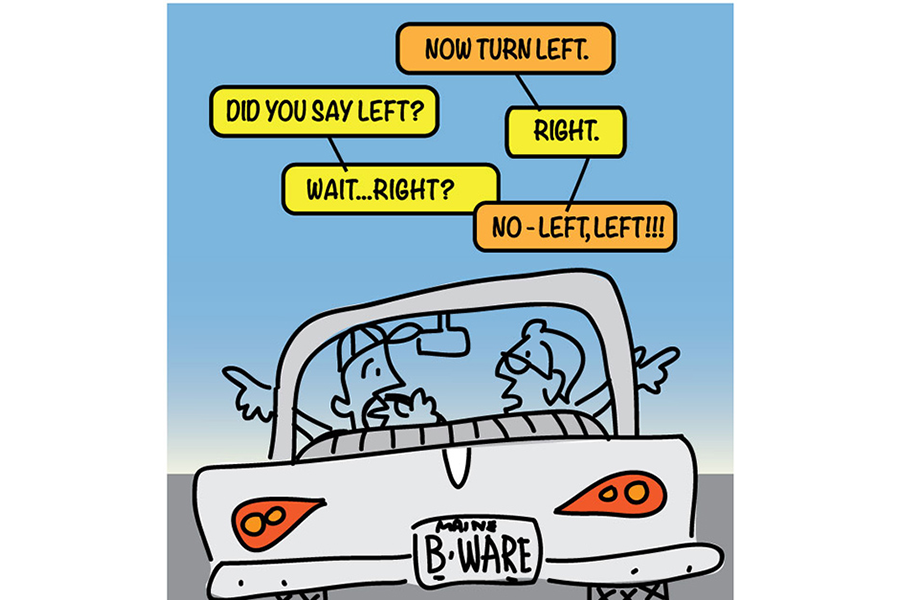Driver’s – and passenger’s – ed
Loading...
Teaching someone to drive can be nerve-
racking under the best of circumstances. The experience of offering instruction from the passenger seat while a new driver is at the wheel is not a formula for peace of mind, especially when, as happened to me recently, the student’s first language is not English.
My good friend Prakash is from southern India. He grew up speaking Telugu, a language that, until I met him, was unknown to me. (Wikipedia notes that Telugu is spoken by some 75 million people, making it anything but a minor tongue.) Prakash is self-conscious about his English, even though I think he speaks it quite well, with a charming, somewhat staccato Indian accent.
Under the pressure of driving instruction, however, his facility sometimes abandons him – especially when it comes to the difference between “right” and “left.”
There is an old Abbott and Costello routine, in which Costello is behind the wheel and Abbott is giving instructions from the back seat. As they try to pull out of a space, Abbott tells Costello, “Turn left.” “Left?” echoes Costello in a bid for verification, to which Abbott replies, “Right.”
Get the picture?
During our inaugural drive, with Prakash gripping the wheel for dear life and staring dead ahead, I told him to turn left onto a side road, whereupon Prakash asked, “Left?” I replied, “That’s right.” And so, without looking, he cruised to the right. “Left! Left!” I commanded, which alarmed him. He straightened the car, composed himself, and politely reminded me that I had said “right,” which, of course, I had. I apologized for the outburst and explained the context of what I had said.
But a few minutes later, when I told him to turn right, he turned left.
We pulled over. “Prakash,” I probed, ever so gently, “do you understand the difference between ‘right’ and ‘left’ in English?” He smiled pleasantly and assured me that he did. I realized that he probably did, but simply had trouble responding to my directives under duress.
And then a solution occurred to me.
“Prakash,” I asked, “how do you say ‘right’ and ‘left’ in Telugu?” The answers (which I’ve transliterated and phoneticized): “kudee” and “yedama.”
We set out again into the flow of traffic. I attempted to chat amiably with him to put his mind at ease, assuring him that he was doing a good job and that there was nothing to worry about so long as he followed the rules and watched out for the drivers who didn’t.
Our turn approached. “Go right,” I advised. But we sailed on. “Right! Right, Prakash!” He became flustered, his eyes darting about. And then I recalled my newly acquired Telugu. “Kudee! Kudee!” I erupted. That did it. We arced to the right and found safe harbor on a quiet side road.
We went on like this for a while. “Go kudee here, Prakash,” I’d say with practiced ease. “OK, now you want to go yedama. Good. And then kudee again.” My inquiries brought other critical words into my burgeoning Telugu vocabulary, among them “nehruga” (straight ahead) and the indispensable “apu!” (stop!), which I was soon employing with élan. I learned that, armed with these four precious fragments of Telugu, I was able to ensure that Prakash and I would live to drive another day.
As we headed down the approach road to his apartment, I felt like a harbor master guiding a freighter into port. “Kudee, Prakash. Now nehruga. Yedama here. Nehruga. OK. Apu!”
Prakash was laughing. “What?” I begged. “What’s so funny?”
“Your Telugu,” he said.
Feigning indignation, I demanded, “What’s wrong with my Telugu?”
“Nothing,” smiled Prakash. “Your Telugu is perfect.”
“Well,” I conceded, “I have a good teacher.”
“As do I,” said Prakash in his self-effacing way. “As do I.”







